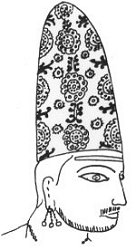The Kulavi Hats
Kulavi: A Forgotten Head-gear of
Medieval Deccan
by Jyotsna Kamat
The Vijayanagar empire (1346-1565 A.D) had made great innovations in arts, architecture, literature, music, and painting. The advancements also involved distinct dresses for men and women. Men wore mini sarees around long coats and decorated their head with colorful caps known as the "Kulavis." These topies were as popular as "Gandhi Caps" of our times. The bronze statues of Krisha Deva Raya (A.D. 1509-1530) located at Chidambaram, Tirupati and Kalahasti give a fairly good idea as how Kulavi looked like. However, wall-paintings of Vijayanagar times located at Papanatheshwar temple at Lepakshi, near Hindupur in Andhra Pradesh truly illustrate the beauty and elegance of these caps.
 |
 |
 |
| Virupanna's Kulavi | Veeranna's Kulavi | Wealthy Man's Kulavi with studded emeralds |
| Medieval Kulavi Fashions | ||
Prior to Vijayanagar period, turbans (Ushnisha) were very common and the aristocrats flaunted "Mahashnisha" with zari and jewels fixed on them. Hence, the Kulavi was the fist tailored head-gear of South India. It had a height of six to eight angulas (approximately one angula = one inch) and fifteen angulas in circumference. The special stiff velvet, satin, taffeta were imported from Alexandria, Damascus and China. In order to make the caps very attractive they were embossed and embroidered with red, purple, yellow or black silk tread. The rich people got jewels and precious stones fixed on them.
Portuguese travelers Barbosa and Paes have left a detail description of this wonderful cap. According to poet Govinda Vaidya, Kantheerava Narasaraja used to wear Kulavi during special "Jambu Savari" of Dasara celebrations.
Kempe Gowda, the builder of Bangalore city used to wear headgear similar to Kulavi. With the fall of Vijayanagar empire, the Kulavi fell out of fashion making room for western "Hat" during British rule.
References:
- Kamat Jyotsna, The Kulavis the Kannadigas Forgot, in Kannada, 1997
- Seetaramaiah M.V. (Ed), Dairy of Krishna Devayaraya, in Kannada, 1983
- Devappa Kavi, 'Rama Vijaya Kavya', 1540
See Also:
- Color Picture of a Kulavi
- Search Kamat PictureSearch for Men's Headgear
- Search for more pictures of Kulavi